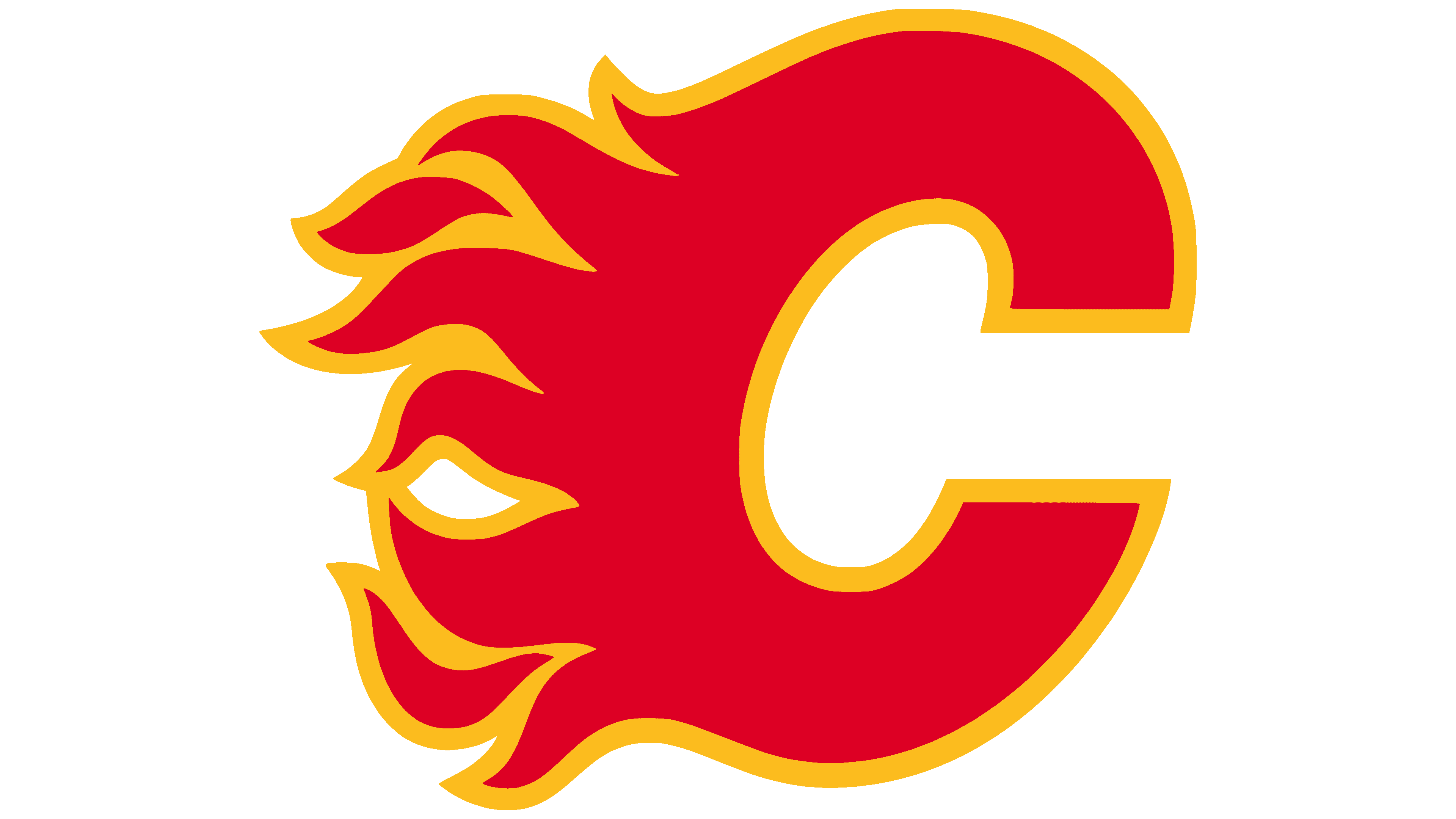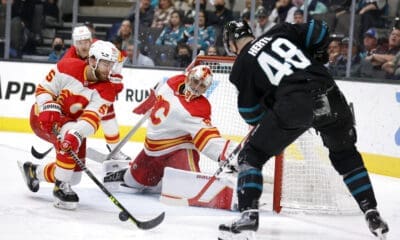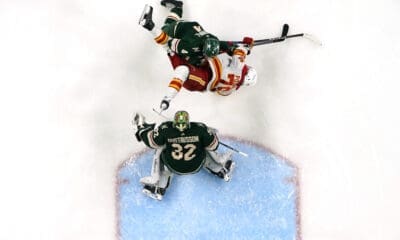Calgary Flames
What if Teemu Selanne became a Flame? Part II: Difficulty
We continue to explore the alternate universe where Teemu Selanne is wearing red, focusing on what life would be like after his rookie season.

Continuing from yesterday’s piece, we’re continuing to ponder what could happen had Teemu Selanne signed an offer sheet with the Calgary Flames back in 1992. So far, we’ve reviewed his rookie season, which becomes an even more absurd one with the addition of a good supporting cast. However, things take a turn for the bad, both for Teemu and the Flames.
1993-94
Selanne's rookie season gets so much in devotion in this series because a) it was amazing, and b) because he started to slip afterwards, which is not so amazing (and it leaves us with less to write about). Turns out it's hard to maintain 20% shooting even if you're the wonderkid of the league
To begin 1993-94, Selanne descended from the heavens and started posting a PPG mark around 1. Regression turned it's ugly head on #13, who began to falter playing against a harder schedule (0.05) thanks to divisional realignment. His season took a turn for the worst when his Achilles tendon was severed in a January game, knocking him out for the rest of the year.
The Flames wouldn’t be that discouraged by his loss; the 93-94 team was their best chance to win the Stanley Cup until a decade later. Again, we’ll use point shares to try and calculate Selanne’s small impact on the 93-94 team. The addition of 4.6 points doesn’t really change the Flames’ position in the division, but it does put them on top of the Western Conference by just one point, which impacts the playoffs.
Despite all lofty assumptions, the 93-94 Western Conference playoffs were a shocker. The Sharks, making their first playoff appearance ever, took down the Red Wings in the first round; the same Red Wings who were the most dominant team in the decade. Vancouver also took down the Flames in a seven game series. This is not promising.
Without Selanne in the picture, the same Flames that lost to the Canucks might also have a hell of a time getting by the Sharks. The beauty of a seven game series is that the chance for fluke is greatly diminished. The Sharks proved that they were no fluke that year, giving the Maple Leafs all they had for seven games. Even as an eight-seed, it’s hard to see the Flames overcome.
But if they did, they’d probably have the Canucks waiting for them regardless. The team of destiny doubted the doubters and went all the way to the Stanley Cup finals to meet the real team of destiny, the New York Rangers. Teemu or not, it’s another disappointing playoff exit for the Flames.
1994-95: The Lockout and the beginning of troubles
With a promising season lost, the Flames could hope to recuperate in time for October 1994. It was a whole new season, and a new time for the NHL in general. A former NBA executive named Gary Bettman became commissioner. His experience and no-nonsense business approach would mean good things for the lea- I'll cut the crap, you know exactly where this is going.
Selanne was destined to play another half-season, owing to the first infamous NHL lockout. When the season began in January 1995, Selanne was ready to go, having spent the first half in Finland playing for Jokerit. The Flames faced a tough offseason owing to many, many departures. Al Macinnis received an offer sheet from the Blues, which the Flames couldn’t match (a sign of things to come). The Blues sent back Phil Housley and two picks (Steve Begin and John Tripp), which isn’t bad for RFA compensation.
The previous season also saw Gary Suter and Paul Ranheim leave the team, Hartford bound in return for Zarley Zalapski and Michael Nylander. The Flames made the wise choice in choosing to jettison older members of the squad, the only problem being that they weren’t necessarily returning younger upgrades. However, the team was still good enough to capture first in the Pacific, and third in the West. Even with a full half season of Selanne, his point share of 5.1 wasn’t enough to gain position in the West, placing them behind the Blues by one point.
The first round saw the Flames meet the Sharks, whom they eventually lost to in seven games. This is where Selanne definitely could've made a difference. Calgary's three wins were by scores of 9-2, 6-4, and 5-0. San Jose's wins were 5-4, 5-4 (OT), 5-3, and 5-4 (OT). We were all probably too young to remember this, but talk about a gut puncher; the type of gut puncher that renders three organs useless.
For myself, it is very easy to believe that the addition of Selanne in this roster would've created maybe one or two goals, and maybe could've ended the series in four. For the sake of this alternate timeline, that happened.
Onto round two, where we once again meet the Canucks, who beat the Blues in six. The Flames and the Blues aren't that different, and it's a close one to call. With Selanne, I again feel that the Flames hold the edge. The '95 Canucks aren't the '94 Canucks, as their wild ride ended abruptly in the second round after Chicago swept them. I'm also tired of giving the Canucks victories in this false world. I control this planet, Canucks lose.
My biased thinking collides with pure reality in the conference finals. The Red Wings had only lost once in the playoffs at that point, and were about to become a dynasty. Flames would’ve lost pretty badly, as the Blackhawks did in reality. Should they do the unthinkable, they’d face the Devils in the finals. Selanne can’t fix that problem.
With a strengthening conference, and a deteriorating roster, there were problems that nobody could fix. With the Nordiques leaving at the end of the season, the writing was on the wall for the Jets and Flames regardless of who had Selanne. Things were looking grim for the next season.
1995-96: Loonie times
This is where things get very, very interesting off the ice. Mostly because the Flames were doomed on the ice. They finished 6th in the conference, and were swept in a series against the Blackhawks being outscored 16-7. The Wings and Avalanche were much better, and Selanne couldn’t have done a thing to prevent the inevitable destruction that would ensue.
If Selanne would be on the team in the first place. 1996 was a terrible year for the city of Winnipeg, first having lost Selanne, then having lost their team. The Canadian dollar was at an all time low, trading to about 60 to 70 cents compared to the American dollar. The NHL dealt in American dollars, and the small market Canadian teams found it hard to compete in an age of rising salaries.
How bad did it get? The Flames nearly lost Robert Reichel to a German team, who were able to offer nearly twice more USD than the Flames wanted to pay him. Every bit of that previous sentence is unthinkable and completely insane in any era of the NHL. The team relented, paying Reichel just north of the $1M USD that Frankfurt was offering.
For the Jets, who very well knew the financial state of the team, they had to make perhaps the worst, most desperate deals a team could possibly make. They infamously traded Kris Draper for $1 in 1993 to get his contract off the books. In 1995, things weren’t any better. Selanne’s first deal ended before the season started. To show that they weren’t absolutely going to surrender to their collectors, and perhaps to not flip off their fans as they left, the Jets signed him for $2.75M.
The nice sentiment didn’t last long. Selanne was unexpectedly traded in the middle of practice in February of 1996 to the Mighty Ducks, in return for prospects Chad Kilger and Oleg Tverdovsky. It was a dagger in the heart.
Just as his career in Winnipeg began because of an offer sheet, it ended the same way. Keith Tkachuk had been offer sheeted by the Blackhawks, and once again, Winnipeg had to match. Paying three forwards (Zhamnov being the third) over $3M was unforseeable, even for the new ownership group. Selanne got the boot.
The Flames were also feeling the pinch. They didn't splash the cash on the open market in the offseasons leading up to 1995-96, signing next to no one and preferring the waiver wire as the means of building a team. Free agents walked away, no matter how big or small; Joel Otto had to be cut loose. Mike Vernon and Phil Housley were traded for scraps just to get big contracts off the book. Michael Nylander fled to the Swiss League because of contract disputes. The hemorrhaging was so bad and the damage so lasting, that the team still struggled financially into the 2000s and nearly left in 1999 . It was approaching disaster.
There was one dispute they couldn’t avoid. Unable to agree to a deal after arbitration, Joe Nieuwendyk held firm and stayed on the sidelines until the Flames paid him. The team eventually relented, changing the face of the franchise forever. Nieuwendyk was off to the Stars for Corey Millen, and some kid who played for the Kamloops Blazers.
#12 or #13?
Let’s go away from real history and dive back into alternate history. The Flames were unable to cope with the declining Canadian dollar, and it was incredibly obvious that the team was willing to sacrifice success to stay in the city. Everyone left, and I mean everyone. From the roster in 92-93, only Theo Fleury, Gary Roberts, Ronnie Stern, Trent Yawney, and Kevin Dahl remained in 1995-96. Two of them would be gone by the start of 96-97.
Could Selanne be a casualty of the times? It's tough to say. The Flames tore down the team with such impunity that they forgot to label someone to build around, but you could argue that's because they had absolutely no one to build around. Fleury was 28 by the start of the fire sale, and the team felt it was unlikely he would be good by the time the team would be good again. He mostly stayed to keep butts in the seats and to give Flames fans a glimmer of hope (he would become a casualty three years later, the Flames being unwilling to pay him $5M per year, $2M less than Fleury was asking for on the open market).
Nieuwendyk's trade was inevitable. Based on the realities of this fictional universe we've created, the Flames haven't been good enough to force Nieuwendyk to consider staying at a cheaper cost (the Flames wanted him at $2M/year, so maybe winning still wouldn't have changed his mind, but I digress). The trade became very unpopular immediately. The way the team had dealt with the entire proceeding plus the perceived less than substantial return made fans believe that this team was doomed. Headlines read "Jarome Who?" that day in Calgary.
Hindsight being 20/20 of course, the return was the greatest thing to ever happen to this franchise.
But if Selanne was in Calgary, could the Jarome Iginla trade have happened? The Flames needed money, but assuming they signed him to a similar contract that Winnipeg did, management may have written off the cost as a necessary expense. A young scorer that had consistently put up points at an average NHL salary? Yes please.
One of the reasons the Flames targeted Iginla in the Nieuwendyk trade was that the team was completely out of right wingers. Besides Fleury (96 points in 95/96), the next best was Sandy McCarthy (16 points). Selanne on the right wing would've solved that whole situation. Nieuwendyk would be traded for someone else's star prospect. Can't really speculate on who, but I have a gut feeling they would get who Winnipeg traded Selanne for, which actually makes things so much worse. Alternatively, they keep Selanne, acquire Iginla, and then holy shit. Holy shit meaning bigger money problems five years later. Let's keep the scope of this article limited.
They could've also traded Selanne, which would be the most likely option. The lack of money and the fear for injury was the reasons cited in Winnipeg. The bigger question would be whether or not it could have been for the Winnipeg package. Trade speculation from the era is far and few between, so we can only look at the history of the GMs involved and try to guess what happened. Al Coates was perhaps the master of making low impact trades; looking through trade history, the biggest question asked is "who?"
However, big deals seemed to be his specialty, even if it wasn’t recognized at the time. Like the Iginla trade, his moves were often questioned and scrutinized, but often turned out to be the right ones. The Flames got the best (very few) years of Valeri Bure for the aging Zalapsky. He acquired Marc Savard for magic beans named Jamie Lundmark and Jan Hlavac. It’s a small sample size, but big deals don’t come very often in a GM’s career. You could hope that Coates acquired someone worthwhile, instead of two players who combined to score 525 points in 1,417 games.
Coates may have made some nice high impact trades, but his other deals were very sketchy, and this is why a Selanne deal would most likely be a steal for the other team. Coates never knew how to draft well, his best pick being Derek Morris in 1996 (Craig Anderson also ranks up there, but he never played for the Flames). The ’97 class included 12 players, but they only played a total of 81 NHL games. Rico Fata, Blair Betts, and Oleg Saprykin were the highlights of his failure. Any picks returned in the trade might have gone to waste.
Coates' bungling of the majority of his GM duties eventually cost him the job leaves us with little hope that the Selanne trade would've brought back anything useful or lasting. Considering the Flames at the time and the absolute tire fire they were, if anyone useful would've come to the team, they might've left for greener pastures soon after, if the Flames could even afford them in the first place.
Conclusion
Like his time with Winnipeg, Selanne's hypothetical time with Calgary would be just as magical and short lived. The weak Canadian dollar was killing small market Canadian teams, and Selanne was a luxury nether of them could've lived with for long. Winnipeg in the early 90s was in the advanced stages of the disease that Calgary had in the mid 90s; declining teams looking to keep the dream alive before they were swallowed up by the reality of the league. The Jets fell under. The Flames nearly did had it not been for an undervalued Dallas Stars draft selection and some shrewd, destructive moves.
Somehow this fun little historical investigation turned into an important message to rebuilding teams. Selanne on the Flames didn't really matter in the long run because the team would never be able to hold onto him for longer than his early seasons, which was irrelevant considering the direction the team was headed. Both the Flames and Jets held onto vain glory, overpaying for it all the way. Holding onto players they had won with, the teams were forced to offload for the sake of being good in the future, or even having a future. While the Flames appear in good hands right now, they're still dangerously close to the cap with many important re-signings in the future. If the team can't manage it's money properly, then the window will slam closed faster than we will realize. I'm not suggesting that the Flames may be moving, but there are some concerning parallels between this current team and the 90s Flames. Hopefully they look to history again to avoid future mistakes.
by xx xx








